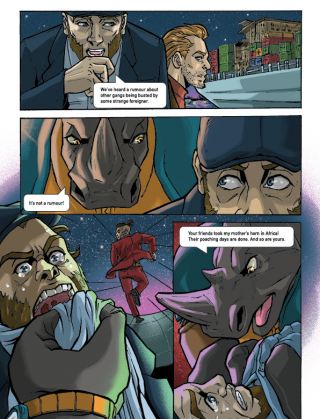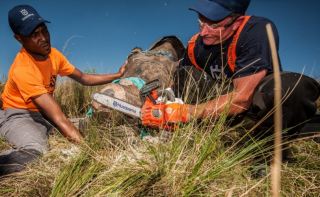Limpopo-Lipadi Private Game & Wilderness Reserve Transforms Conservation with Strong Anti-Poaching Stance
Three rhinos are poached every single day in Africa. More than 1,000 rhinos have died in South Africa annually since 2012. The poaching threat continues to spread across borders and countries as illegal demand grows. For the Limpopo-Lipadi Private Game & Wilderness Reserve, located in the Tuli Block in Botswana, preventing poaching through intelligent measures is critical to preserving the lives of these increasingly endangered animals.
This Reserve has invested into anti-poaching measures that are designed to protect the rhino, their legacy and the safety of all its animals. “There has been an increase in rhino poaching Botswana over the past few months – seven rhinos have been killed in Botswana since May - and we have implemented measures designed to counteract this worrying trend,” says Kevin MacFarlane, Reserve Manager of Limpopo-Lipadi.
“We have decided to double down on our anti-poaching efforts to keep rhinos out of harm’s way by upping our commitment to rigorous anti-poaching methods that include working with the Botswana government, the Department of Wildlife and National Parks and the Botswana Defence Force, investing into our own anti-poaching team and de-horning our rhinos.”
The reserve has invested into training and reinforcements for its anti-poaching unit and their work is further supported by the well-armed Botswana Defence Force. Highly trained tracker dogs, complement Kalahari bushmen trackers to patrol the perimeter to detect intruders on the reserve, night and the day. “As part of our conservation and anti-poaching efforts, The Botswana Department of Wildlife and National Parks has allowed us to de-horn our rhinos,” says MacFarlane.
“Thanks to this initiative, today we can say that there are no horns available for poaching in our reserve. We will be repeating this de-horning process at least once a year, so we can focus on our efforts to protect and breed rhinos and help rebuild their flagging numbers. We are also working closely with the Department’s anti-poaching unit to protect all wildlife in the Tuli Block.” Limpopo-Lipadi has become home to a number of rhinos over the past ten years. The de-horning programme will now allow for these animals to continue to breed safely - it forms a critical part of the reserve’s conservation efforts and draws a clear line under its anti-poaching stance.
It is also being undertaken with extreme care to ensure that the risk to the rhinos is minimal. “We work with one of the most experienced rhino vets in Southern Africa, Dr Erik Vereynne,” concludes MacFarlane. “His understanding of technique, drugs and animal care has meant that our rhinos have felt minimal stress throughout the procedure. Thanks to his work and our passion for protecting these magnificent animals we are making great strides in protecting the wildlife that thrives in our beautiful Reserve.”
To find out more about Limpopo-Lipadi Private Game & Wildnerness Reserve and its conservation work visit www.limpopo-lipadi.org or call: + 267 724 79048.
Rhino Ranger returns to stop the demand for rhino horn in Vietnam
Vietnam is the worlds largest recipient of illegal rhino horn from South Africa. To reduce rhino horn consumption and therefore demand, Wilderness Foundation Africa is working with school-going Vietnamese youngsters to create a generation of ambassadors who will grow up to be in a position to influence their peers, parents and families to reduce and ultimately stop the demand for rhino horn.
Building on the story and campaign developed with the expertise of Boomtown in 2015, Rhino Ranger returns this month for a second instalment of the Rhino Ranger comic book. Rhino Ranger is a superhero character that was conceptualised and created to spread the message of the “Wild Rhino | Vietnam, be my Hero” campaign to the target audience in Vietnam. The story of Rhino Ranger continues as he travels to Vietnam to discover why his mother was killed in South Africa. “Our first edition was incredibly popular, and our competition to become a Wild Rhino Youth Ambassador has been a huge success,” remarks Cheryl Reynolds, Relationship and Communications Manager of Wilderness Foundation Africa. "To target a younger audience, we are adding an activity book for those under 12. It's incredibly exciting to see the campaign grow and reach more young Vietnamese children and mould future generations.”
Using cultural insights, the personal experience of the Wilderness Foundation Africa team who have been to Vietnam on various occasions throughout the campaign, Boomtown was able to create a comic that was truly believable to its readership. “The appearance of streets and the depiction of the culture need to be a true reflection of Vietnam,” remarks Andrew MacKenzie, Boomtown Managing Director, who has visited Vietnam with the Wilderness Foundation Africa when it first launched Rhino Ranger. “We need the youth that we engage with to buy into the campaign and become ambassadors for change. We cannot do that if they cannot connect with our content.”
The story for each edition is left open-ended to feed a hunger to know more and create word of mouth between children in the playground, in the classroom and at home.
Published alternate years, the comic is complimented by a competition to become a Wild Rhino Youth Ambassador and visit South Africa to experience rhino in their natural habitat. Junior children are chosen through a competition to draw a picture and write a poem, and senior children are tasked to write an essay on reducing the demand for rhino horn.
In addition to expanding the Rhino Ranger story and material, the campaign is extending to international schools in Hanoi. “We have already had a great reception from the international schools we are working within Ho Chi Minh City, and the team is excited to launch in Hanoi this September,” adds Reynolds.
The Wilderness Foundation Africa team will visit Vietnam in September 2018 to launch the third round of the Wild Rhino competition, and distribute the Rhino Ranger comic book and activity book, along with other marketing collateral to the participating schools in Ho Chi Minh City and Hanoi.
Partnering up in KwaZulu-Natal to save rhinos
The beautiful 700ha Gwahumbe Game & Spa in Mid-Illovo, KwaZulu-Natal, is the latest private reserve to join the ranks of others which have dehorned their rhinos.
Its partnership with Husqvarna and Hilton veterinary surgeon Dr Ryan van Deventer will, hopefully, ensure the survival of the lodge’s last remaining male rhino, eight-year-old Vuyo – and finally allow the expansion of its herd.
Previously, said Gwahumbe Game & Spa director Shanon MacKenzie, “We were too anxious about Vuyo’s safety to allow him to be photographed, and we postponed adding to the herd because of the risk of poachers wanting their horns. We are extremely fond of him: he came here when he was just three. The decision to dehorn him was made with his survival and safety very much at the forefront of our minds.”
The devastating decline in the rhino population – and the poachers’ savagery– is just one of the issues on the agenda for this year’s CITES COP17 Conference* (24 September-5 October in Johannesburg). Sadly, the battle for the animal’s survival has been a losing one, until recently.
A local rhino-dehorning campaign, using Husqvarna outdoor power products, is proving highly successful in the bid to save these beautiful animals from poachers. In KwaZulu-Natal, particularly, the practice is gaining momentum, with increasing numbers of private game reserves voting for this option. The process was first used to help reduce poaching pressure in Zimbabwe in the 1980s. When rhinos are dehorned professionally, the horn is taken above the growth layer of the skin. Rhino horn is like a fingernail: you can cut it or trim it without stopping continued growth. But poachers brutally uproot the entire horn from its base under the skin in the bone.
Vet Dr Ryan van Deventer started working on the dehorning project a year ago in various KwaZulu-Natal areas, including, more recently, at the popular Gwahumbe Game & Spa. “Before dehorning, many rhino owners used ankle bracelets and horn transmitters for monitoring purposes,” he said.
“Although some of them are still resistant to dehorning, as the poaching problem escalates more and more reserves are realising they need to minimise the risk to the animals. It’s not a total solution to the problem but merely part of a holistic plan to try to prevent poaching.”
The Husqvarna Group, a global frontrunner in the manufacture of forest, agricultural and garden power products, has provided Van Deventer with a battery chainsaw and a petrol one – the petrol saw for the initial cutting, and the battery saw for the finer trimming. Some vets who work with rhinos are also relying on Husqvarna’s battery blowers to keep the rhino cool during the dehorning process. Battery products are fuel free so produce no harmful emissions. They are also quieter than their petrol equivalents and lower noise levels mean less anxiety for the sedated animal.
“The Husqvarna chainsaw is quicker than an oscillating saw,” said Van Deventer. “Once the animal is immobilised and stable, the procedure takes about 20-30 minutes.”
He said the Husqvarna blower played a vital role in keeping the rhino’s core body temperature down, which was particularly important during the procedure, especially in the hotter seasons. “There is always a risk with anaesthesia, and added to this is that white rhinos are particularly sensitive to the opioids. So we want to perform the dehorning as efficiently and quickly as possible.”
He said the recommended method to reduce poaching risk was to remove the horn as low to the base as possible, in addition to removing the side walls of the horn. This just leaves a small rounded bump of horn, reducing the poaching risk to the animal.”
Horns do grow back with time, but the rate depends on nutrition. “Animals receiving a lot of supplementary feeding have faster horn growth, so dehorning every 15-24 months is a good guide. But saying that, it’s not good enough to merely dehorn and expect there to be no poaching threat: you must ensure other checks are also in place.”
The plight of the rhino has gained international attention, and around the globe, various campaigns are creating awareness and raising funds to help conserve the animal.
Stefan Terblanche, former Springbok rugby player and CEO of the Rugby Legends, has added his voice to the chorus: “We must do all we can to reduce rhino poaching and I’m proud that we can help save the animal for future generations. It’s far better to have a dehorned rhino that is alive and that we can still enjoy seeing in our reserves.”
Husqvarna South Africa’s marketing manager Jacqui Cochran said: “We are extremely committed to this project, and thrilled that our diverse range of equipment is being used for a cause as worthwhile as saving the rhino.”
For more information about Husqvarna, visit www.husqvarna.co.za and www.gwahumbe.co.za
Ends



